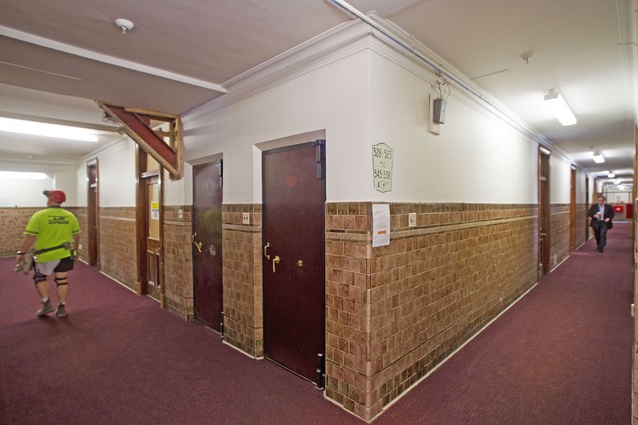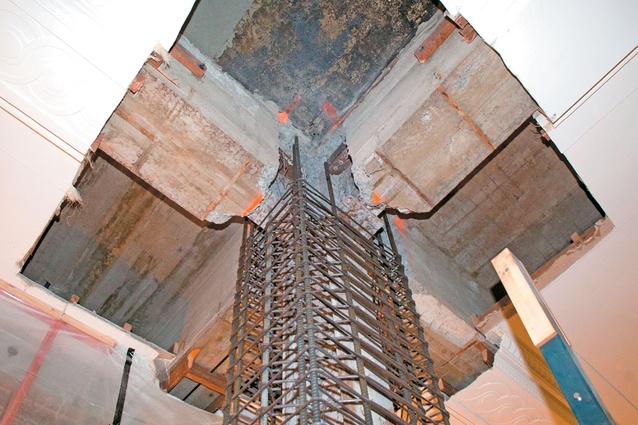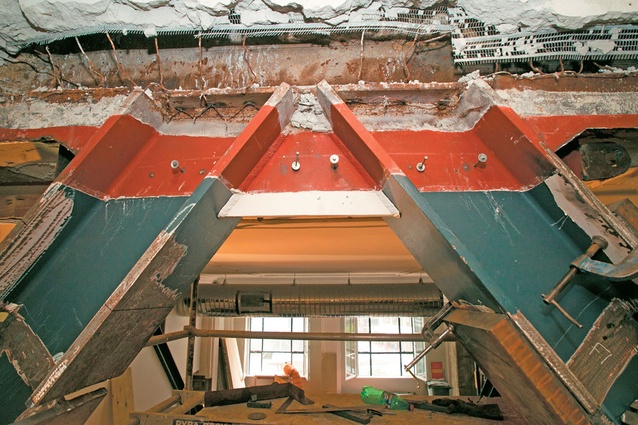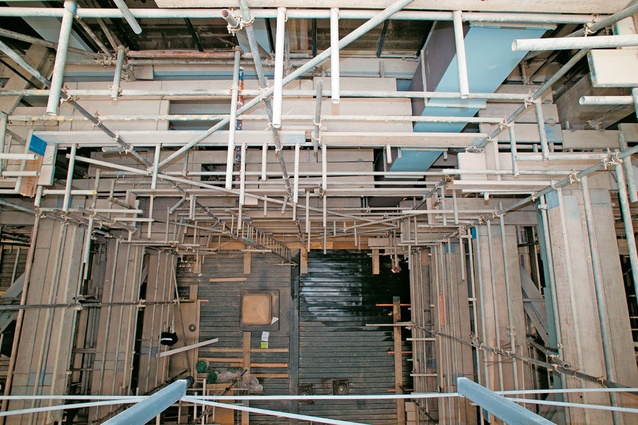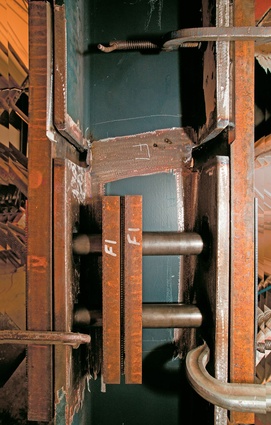DIC building gets a makeover
One of Wellington’s landmark buildings is undergoing major seismic strengthening. The old DIC Building on Lambton Quay gets a different kind of makeover.
The former DIC Building, now Harbour City Centre, 179 -193 Lambton Quay was built in 1928, before earthquake performance codes existed. It is a registered Category II heritage building. The owners, Kirkcaldie & Stains Ltd, contracted structural engineering consultants, Dunning Thornton, and building contractors, LT McGuinness to carry out, respectively, the structural design and construction – work that will bring the building close to 100 percent of current code in terms of collapse prevention.
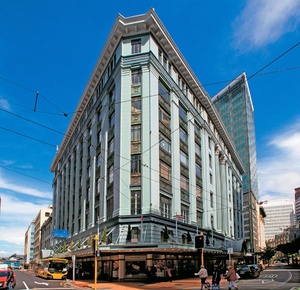
The six storey steel frame and concrete building (including floors and roof) was originally built for the Drapery and General Importing Co. (DIC). The architectural style has been described as ‘free classical’. “It has been a matter of improving rather than rebuilding,” says Dan McGuinness from LT McGuinness. “The building has been well looked after.”
The work includes interior fit-outs for some of the long-term tenants including a major fit-out for Contact Energy. Harbour City is the largest seismic project undertaken by TT McGuinness while the building is occupied during construction. The Odlins Building, Chews Lane and other large buildings they worked on were not occupied during construction.
At times the complex staging process involved working night shifts to minimise disruption to the tenants, who occupy all but one and half levels. “It’s nearly a 24 hour operation. [Night work] made it more efficient and effective,” says McGuinness. “We set up the project to deal with it and it has worked really well.” Detailed planning began in 2010. RCP project managers Andrew Field and Tristan McDonald noted that the early involvement of the contractors contributed greatly to the success of the project, which is targeted for completion in March.
“It’s not so much the technical challenges as the environment. Risk mitigation was considerable,” says Field. During a site visit in late November 2011 work was underway on level one to strengthen columns and steel braces, while below shoppers scanned racks of clothing in the new fit-out of Country Road’s store. The mezzanine in the ground floor has been removed and the shop relocated into a single space, one and half storeys high with services above.
The 21st century fit-outs here and at Contact Energy’s new open plan offices on level three mark the changes in approach to work environments. The original mottled-brown wall tiling, dark wood and narrow corridors in the floors above are still fully functional. Staging the work in a fully occupied building has been complex. To reconfigure the ground floor they divided the retail space into three sections, allowing businesses to operate while construction went on behind acoustic wall panels.
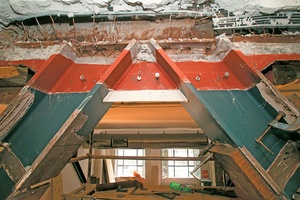
“It meant a lot of night time work, and good communication between us and the builder to make sure we kept everything running smoothly,” says John Milford, managing director of Kirkcaldie & Stains. The owners were motivated by the requirements of their tenants and the desire to maintain a safe, code compliant building. The approximate cost of the project is $4.5 million. V-frame braces with dampers inserted were visible on level one, as were columns in various stages of improvement – from the original steel, stripped of the old fireproofing concrete, through to reinforcing and timber formwork. New, self-compacting concrete lends additional strength to the columns.
The contractors have moved around the floors, tenants relocated when new space is ready. Site manager Dion Russell says they worked with the engineers to arrive at a suitable construction methodology that took into account the unforeseen. “You can’t really know what you’ll find when you take a wall apart, or how much damage there’ll be to the interior.” They were impressed by the condition and strength of the original bolting connections to the foundations, which matched the drawings and documentation.
The method adopted to strengthen the columns also took account of the tenants. Columns are reinforced and concreted from the lower floors going up, to meet the other part coming down where they are joined by couplers. Structural engineers Dunning Thornton assessed the seismic strength of the building in 2008 at the request of Kirkcaldie & Stains. Consulting structural engineer Adam Thornton says, for its day, the building was well designed and built, but that it was not specifically designed for earthquake loading. The building was strengthened in the 1970s using concentric, inverted V-frame braces. However, when assessed against the requirements of the 2004 Building Act, the building’s performance was again below the threshold for earthquake prone buildings.
“Although its elastic strength was at a reasonable level, it really didn’t have any significant post-elastic (plastic) capacity,” says Thornton. “The V- brace strengthening that had been installed didn’t meet ductility requirements. They were concentric braces without the ability to yield in compression. Such braces are prone to buckling in compression with consequential loss of strength.” He says they considered options, one of which was to remove the braces and start the strengthening again. However, they were able to modify the braces by inserting dampers to give the required post-elastic performance. The dampers can yield in a ductile manner, limiting how much load comes into the building and preventing the braces from buckling. They absorb the energy and dampen the response of the building.
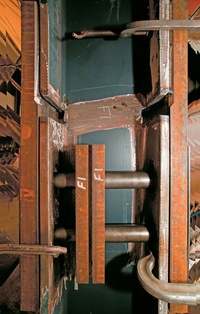
The other primary structural elements within the building are then checked to ensure that they have capacity in excess of the damper yield loads. This hierarchy of strength avoids yielding where it is not expected. “The dampers will lift the performance well above one third and give the building the ability to go beyond the elastic range – ie become ductile,” says Thornton. Every brace is connected into the base of a column. Anchor piles with high-tension capacity have been added to provide extra foundation strength.
“These anchors hold the columns down when the braces are in tension – they actually work both ways and also provide additional compression capacity.” The project went through a normal consent process. The engineers identified early on that there were some unusual aspects requiring innovative solutions. These were discussed with the building consent authorities at Wellington City Council and the design was peer-reviewed.
To create the design unique to this building the engineers started from first principles and a desire to utilise the strengths of the existing building. Thornton says this is an approach applicable to most seismic retrofit projects. In this case, because of the innovative approach used, prototypes were built first and laboratory tested. “Buildings designed prior to the 1970s won’t have [a built-in] hierarchy of strength [as do modern structures]. When we look at assessing older buildings we have to look for all the potential vulnerabilities or weak links. It requires a rigorous process and in many ways is more complex than designing a new building,” says Thornton.
Wellington is part of a bigger picture that includes the effects of the recent earthquakes in Christchurch. “New Zealand has this problem – we are a small country and we effectively have some very expensive eggs in a few seismic baskets. That is, we have some seismically vulnerable cities where, if you get a lot of damage, it can adversely affect the economy of the whole country.”
In the event of a large earthquake, lifting the strength of the building stock means New Zealand will be better prepared and more resilient, both with regard to life-safety and economic strength.

